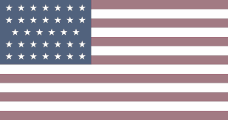 Open main menu
Open main menu
 Open main menu
Open main menu

Commanding Officer on the Antietam Campaign:
Lt. Edward D. Muhlenberg
Arms:
6 Napoleon
This Battery's Chain of Command:
Army - Army of the Potomac
Corps - Twelfth Army Corps
Division - Twelfth Corps Artillery
Unit history
"Battery F arrived in Washington from the West on the 18th of April, 1861, after having had a number of its men injured from stones, etc., thrown by the mob while passing through Baltimore. It was sent to Carlisle in June and there equipped as a light battery (four 6-pounder guns and two 12-pounder howitzers) and formed part of Patterson's command, the sections being distributed to the different brigades. The battery was first engaged at Falling Waters July 2d, 1861; July 8th it is reported as attached to Stone's brigade."
"In the organization of the Army, October 15, 1861, it was assigned to Banks' division, of which it then formed part, and was engaged for several days in December in defending dams Nos. 4 and 5. In the reorganization of March, 1862, it was assigned to the First (Williams') Division of the Fifth (Banks') Corps. One section was in action at Newton May 24th, and the entire battery fought in the battle of Winchester the following day. In June, 1862, the armament was changed to six 12-pounder Napoleon guns. When Pope's army was formed Banks' corps became the Second Corps. At Cedar Mountain the battery fought hard and well, suffering severely and losing, by an accident, one gun in the retreat. After Pope's campaign Banks' corps was made the 12th Corps (General Mansfield's) which, after Antietam, became Slocum's."
On the Antietam Campaign
"The battery was, in the reorganization, taken from the division to form part of the artillery brigade of the corps, and was held in reserve at Antietam and not engaged during the battle."
Statistics
Initial Strength: 98;
Battlefield Tablets for this Unit
Tablet #120: Army of the Potomac - 17 Sep, 5 AM to 17 Sep, 12 PM
Tablet #27: Twelfth Army Corps - 17 Sep, 6 AM to 17 Sep, 12 PM
After the Antietam Campaign
"It was at Chancellorsville that it covered itself with glory, being engaged May 1st, 2d and 3d. Lieut. E. D. Muhlenberg, with his guns at the angle near Geary, did work of which the battery may well feel proud, for with 'courage, coolness and indomitable bravery-he contended against the fearful odds before him until every gunner was killed or wounded at his post, seven horses killed and his ammunition exhausted.' Lieutenant F. B. Crosby, a most gallant and efficient officer of the battery, was killed on the 3d."
We next find the battery engaged at Gettysburg, when July 2d it was in action near Culp's Hill, and on the following day, placed about the centre of the line of the 12th Corps, it rendered valuable service by its work against the enemy. That ended the fighting of F Battery for the War."
"It went West with the 12th Corps that fall, and in the spring of 1864 was sent to Nashville to form part of the first division of the reserve artillery of the Army of the Cumberland. In October, 1864, it was dismounted, the privates assigned to M Battery, and the officers and non-commissioned officers sent east to recruit. It was not remounted nor did it again rejoin the forces in the field."
References & Notes
Quotes above from Dyer's Fourth Regiment of Artillery (pp. 365-366) in The Army of the US, Historical Sketches of Staff and Line (1896); it's online from the US Army Center of Military History.
We have 3 individuals in the AotW database who were on the Maryland Campaign with this unit:
| Co. | Rank | Name | Casualty? | Details* |
|---|---|---|---|---|
| -- | Lt | Cushing, Harry Cooke | | |
| -- | Lt | Muhlenberg, Edward Duchman | | |
| -- | Pvt | Welch, James | |
* If there's a symbol in the Details column ...![]() - We have a picture for this person
- We have a picture for this person![]() - We have details beyond name and rank
- We have details beyond name and rank
Click on their last name to see more